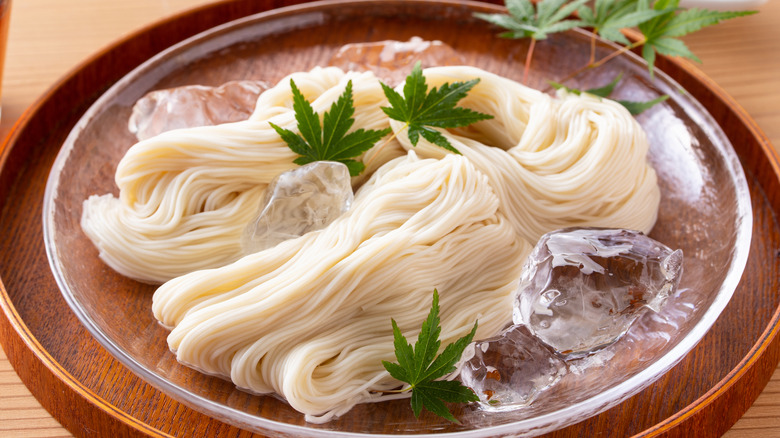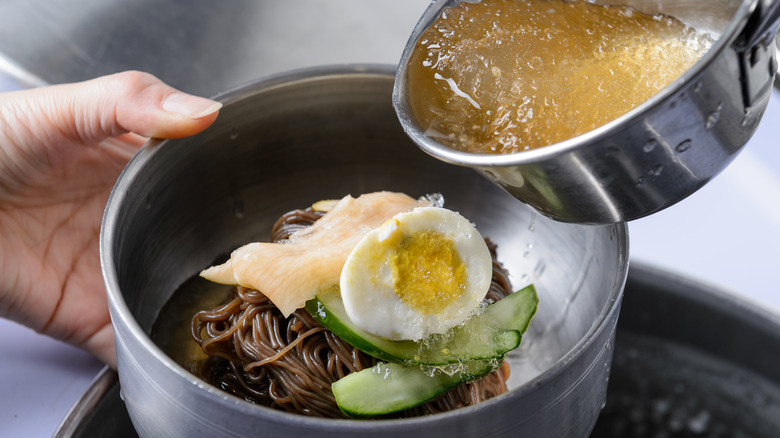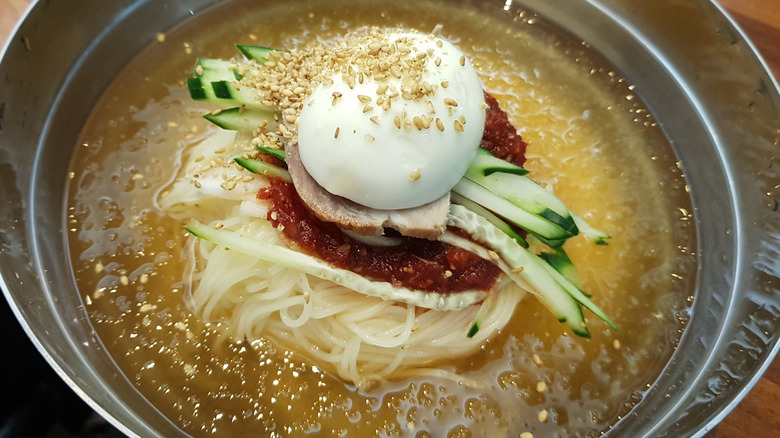The Noodle Dish North Korean Refugees Invented In The South
Cold noodles are a quintessential part of Korean cuisine that combines the heartiness of a meat-based broth with the refreshing tang of vinegar. One of Korea's most famous cold noodle dishes is mul naengmyeon, which translates to "cold noodles." However, there are other noodle dishes, similar in composition yet quite different in preparation, that are worth mentioning. According to Maangchi, there's dongchimi guksu, which comes in a kimchi radish brine and bibim guksu, a spicy mixed cold noodle dish with gochujang and traditional cabbage kimchi. One other tried and true tradition is Busan milmyeon — or milmyeon for short, a cold noodle dish local to Busan (per Baekin Kitchen).
Busan milmyeon was bred out of displacement, but it remains an iconic noodle dish Koreans enjoy in Busan (via KOCIS). Thin, thread-like noodles are dunked in a clear beef broth and topped with different pickled garnishes. It's quite similar to naengmyeon, but it remains a unique dish that pays homage to those who invented it under difficult circumstances.
Paying homage to naengmyeon
Milmyeon's origins can't be discussed without an ode to naengmyeon, its forefather. Koryo Group states that naengmyeon was birthed sometime during the Joseon Dynasty but originated from the northern region of Korea. Pyongyang, the capital of North Korea, is famous for its lighter version, typically made with beef and radish kimchi water, along with toppings like sliced meat, kimchi, cucumber, and a boiled egg. When the Korean War broke out, many Northerners fled to the South, bringing with them this dish.
However, with displacement came certain restrictions, especially when it came to accessing ingredients. Buckwheat, the grain from which naengmyeon noodles are traditionally made, was scarce in the South, per KOCIS. Northern refugees found buckwheat hard to come by, so it became a luxury. Those who settled in the seaside village of Busan continued to make naengmyeon, but with a more readily available ingredient: wheat flour (via KOCIS). Wheat flour was abundant in the South thanks to American food rations, making it the flour of choice for various grain-based dishes. According to Hap Korea, Milmyeon translates to "wheat noodle," but it's also called Busan milmyeon to distinguish it from other dishes that use the same type of noodles.
The noodles and broth are different
The most notable difference between Naengmyeon and Milmyeon is the type of noodle used. Naengmyeon is made with chewy buckwheat noodles, which have a brown or gray tint. Buckwheat grain is much heartier than wheat and is gluten-free, according to Kimchi Mari. Although they lack gluten, these noodles have a very elastic bite, which can make eating them feel like an intense textural experience. Paired with tart ice broth and crunchy vegetable toppings, buckwheat noodles are quite satisfying on a hot day.
Milmyeon, on the other hand, uses somyeon, a thin, wheat-flour-based noodle that lacks the chew of naengmyeon's buckwheat noodles (via Maangchi). However, they are the most versatile type of noodle and can be found in many Korean classics: bibim guksu, "banquet noodles," and dongchimi guksu, per Korean Bapsang. Somyeon is neutral in flavor and white in color, making it an excellent base for any dish.
Besides the noodles, milmyeon looks identical to naengmyeon: Noodles are submerged in an amber-toned slush and garnished heavily. But mul naengmyeon is a simple beef broth combined with sweet and sour kimchi brine, whereas milmyeon is not as one-dimensional. SBS Now shows that traditional medicinal ingredients, including star anise, licorice, and Cnidii Rhizoma, are sometimes added, taking on a unique and nutritionally dense broth with a depth of spices and aromas (via YouTube).
How milmyeon is made
Some simplify Busan milmyeon using prepackaged naengmyeon broth, notes Baekin Kitchen. This is perhaps the closest thing a home chef can get to Busan milmyeon, given that the dish is, in some ways, just an alternative form of naengmyeon. However, preparation for this cold noodle dish can be rather involved, per SBS Now's demonstration (via YouTube). The broth, made of pork and beef bones, takes days to prepare so that the fat and flavor are infused into the soup. Then, the medicinal elements are added to an artificial tea bag — a hollowed-out radish filled with medicinal dried herbs.
The radish is bound together and cooked in the meat broth until softened. The spicy garnish sauce, or dadaegi, is made with ground onions, minced garlic, Korean red chili pepper, and soy sauce.Once the broth is sufficiently frozen into a slush-like texture, the cooked somyeon noodles are nestled at the center of the bowl, garnished with egg, pickles, kimchi, and dadaegi, and then drowned in the cold beef broth.



